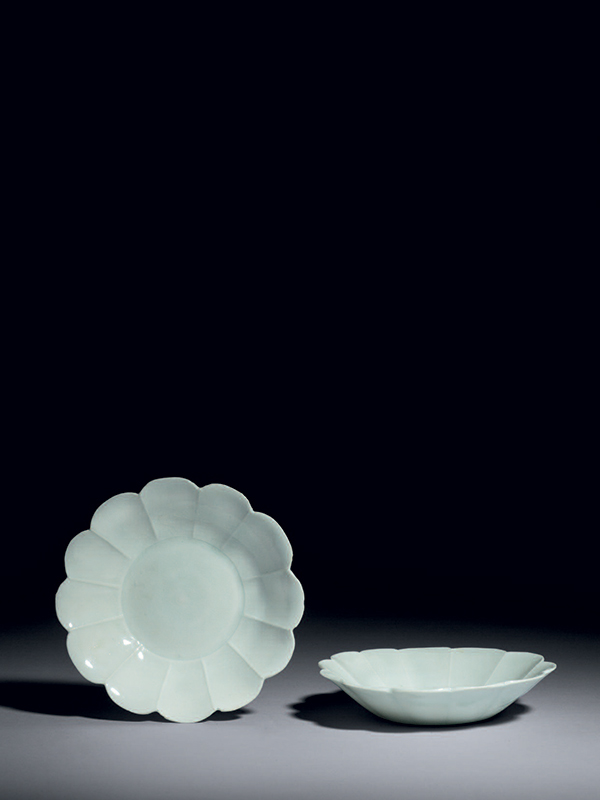Two qingbai porcelain saucers
Two porcelain saucers in the form of an open chrysanthemum flower, each with a slightly concave base and thinly potted, gently curved sides. Raised ribs and notches divide the wide, upturned rims into twelve lobes. Both dishes are entirely unadorned and covered in a transparent glaze of pale blue hue, leaving only the base unglazed, showing the fine-grained white porcelain body and characteristic brown firing marks.
Ceramic forms of the Song dynasty are inspired first by Tang silver and later also by Song lacquer ware. Red and black lacquer dishes from this period have survived in some quantity and like these delicate porcelain dishes rely purely on their shape for effect.[1] Qingbai, literally bluish-white colour, is perhaps the result of a wish to produce a jade-like texture. Porcelain saucers of this type and form are associated with the kilns of Hutian, near Jingdezhen.[2] The chrysanthemum flower is a symbol both of autumn and of longevity; it blooms in frost and icy winds and is noted for its health-giving properties.[3] Dishes such as these usually have an even number of lobes: eight, ten or twelve. Yang illustrates a similar foliate saucer with ten lobes from a tomb dateable to 1090 AD in Pengze county.[4] A number of closely comparable twelve-lobed saucers are respectively in the collections of the British Museum,[5] the Victoria and Albert Museum,[6] and the Kai-Yin Lo Collection.[7]
PROVENANCE
Collection of Prof. Michael Besser, London
- For a comparable lacquer dish in the collection of the Victoria and Albert Museum, London, see: Garner, H., Chinese Lacquer, London, 1979, no. 21, p. 52
- Zhao, Ziqiang and Liu Xinxin, Chai Kiln & Hutian Kiln, 2004, pp. 77 and 160
- Tse Bartholomew, T., Hidden Meanings in Chinese Art, Asian Art Museum, San Francisco, 2006, 7.11, p, 175
- Yang, Houli et al, Dated Qingbai Wares of the Song and Yuan dynasties, Cheng Ling Foundation, Hong Kong, 1999, no. 21, p. 49
- Pierson, S. ed., Qingbai Ware: Chinese Porcelain of the Song and Yuan Dynasties, Percival David Collection of Chinese Art, London, 2002, nos. 31 and 32, pp. 789
- Pierson, S. ed., op. cit., no. 29, p. 76
- Lo, KaiYin ed., Bright as Silver White as Snow-Chinese White Ceramics from late Tang to Yuan Dynasty, Yungmingtang, Hong Kong, 1998, pl. 37, pp. 1589

